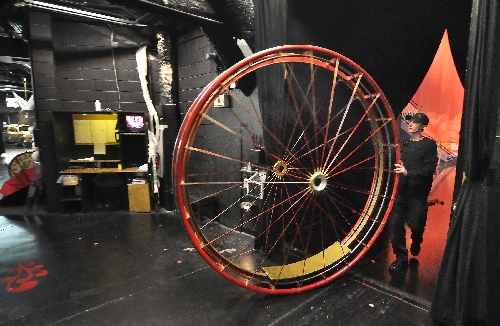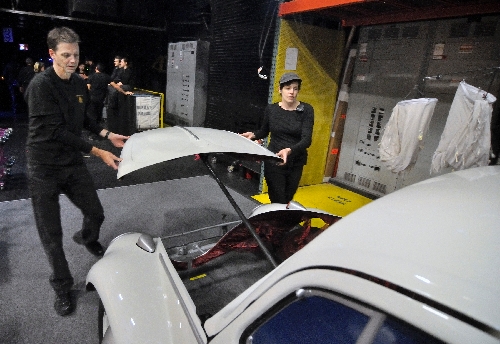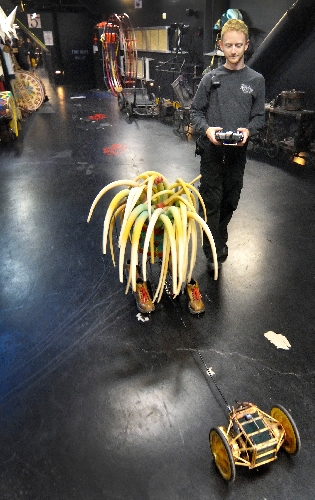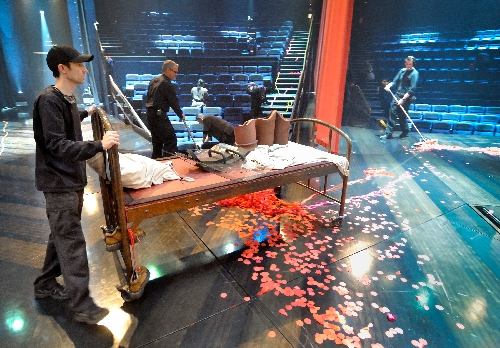Props team keeps pieces in place as ‘Love’ cast flies
When the white Volkswagen Beetle drives onstage as "Day in the Life" crescendos, it is at least the third time the little car has made an appearance in the Beatles "Love" at The Mirage.
By this time, the audience is used to its familiar shape puttering across the stage. When it suddenly breaks into 11 pieces, revealing 11 artists inside, audience members gasp. After the artists finish the number, the car pieces vanish from the stage and the Cirque du Soleil show continues.
The breakaway car, as the Volkswagen Bug is called, may be out of sight and out of mind for the audience. But it is still very much on the minds of people in the props department. The pieces lie backstage in a corner, ready for the crew to reassemble for the next show.
Luckily, that isn't as difficult as it sounds, because the car is held together by magnets, says Richard Amiss, head of props for "Love." And although it is one of the most unusual props in the show, it is far from the most challenging.
"If people only knew that we weren't just handing out handkerchiefs and eyeglasses," says Amiss, who has been with "Love" since it opened in 2006.
Usually, a props department deals with flowers, eyeglasses, handkerchiefs and other small items that are handed to actors as they go onstage. In "Love," the nine-person props crew is responsible for 570 items. There are the traditional props: a box of candy, bouquets of flowers. But they also oversee remote-controlled trains, 35-foot paper puppets, three Volkswagen Beetles, remote-controlled tricycles, soap bubbles and four of the world's smallest fog machines.
Their smallest prop? A whistle for the character Sgt. Pepper. The largest props are the paper puppets, but the most expensive prop, by far, is the breakaway car. Although Amiss wouldn't give an exact dollar amount, he says it costs thousands, more than a real car.
Though it is one of the smallest departments, the props crew is an integral part of the show. They ensure that important pieces of the show are in place when needed and they operate props while they are onstage. His crew does such a good job, Amiss says, he can't remember the last time they made a mistake. Knock on wood.
Six nights a week, the props crew comes in about an hour early to start setting up for that night's two performances. Every night, two crew members must drive the Trains of Light onstage; another crew member operates a tricycle and a drum. All are remote controlled.
Two other props people set up and operate the paper puppets that "dance" with artists during the number "While My Guitar Gently Weeps."
Other props include four umbrellas featuring the world's smallest fog machines. The four "Nowhere Men" carry the umbrellas throughout the show. There are 50 umbrellas in the show, and they break frequently.
"One of my prime jobs is to run spares out during the show," Amiss says.
Making its appearance during "Strawberry Fields Forever," the bubble piano is filled with bubble liquid that actors use to blow bubbles. The liquid is their proprietary formula, Amiss says. They make two 10-gallon batches every week. It takes about one hour to make the liquid.
Of all their props, those that require manual operation are the most challenging, because they demand intense focus and leave little room for error, Amiss says.
"Driving the train and tricycle isn't something you can train just in the course of doing the job," Amiss says.
Besides their regular duties, crew members must practice driving the remote-controlled vehicles at least 15 minutes every week. That doesn't include the time it takes to train someone on those props, Amiss notes.
During a recent performance, two technicians stood in the wings, radio controllers in hand. About 50 feet away, on the opposite side of where they stood, two Trains of Light slowly made their way onstage. "Here Comes the Sun" played on the speakers as the trains made a symmetrical loop before coming to a stop.
Each train consists of 33 cars, with three lighted candles on each car. The trains were included in the original storyboard for the show, Amiss says, but once they were brought into the theater, they had to play with them to figure out how to get them to work in the best way. A brake was added to the rear of each as a safety feature, since the trains operate so closely to an opening in the stage.
This is the best part of the job, says props technician Brett Geiger.
Indeed, the job of props technician for the Beatles "Love" is like a giant toy box for adult children. It involves climbing ladders, running up and down stairs, playing with trains, cars, tricycles and more.
Still, every night, Amiss says, "there are moments of high tension and moments of wait and see what happens next."
Contact reporter Sonya Padgett at spadgett@review
journal.com or 702-380-4564. Follow @StripSonya on Twitter.






















